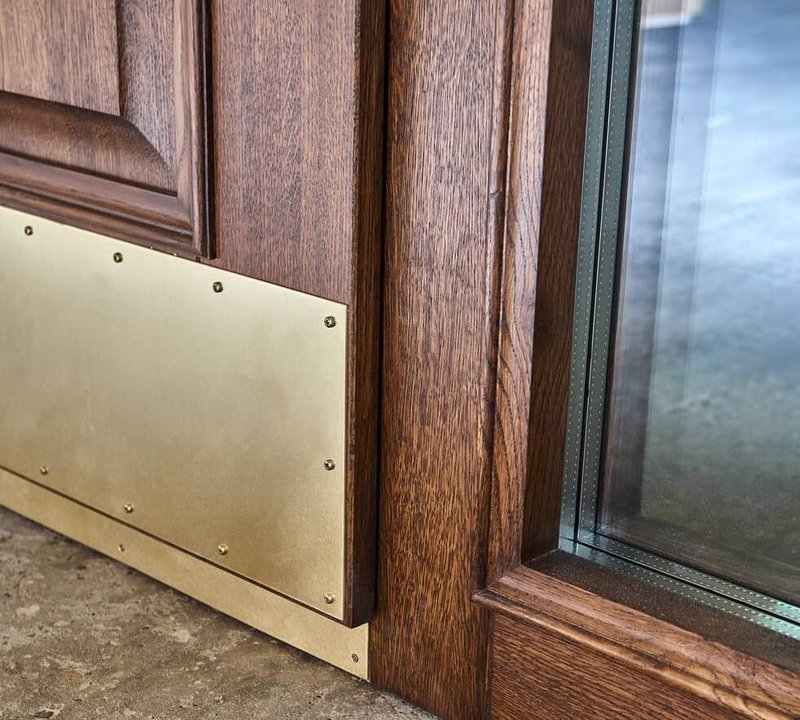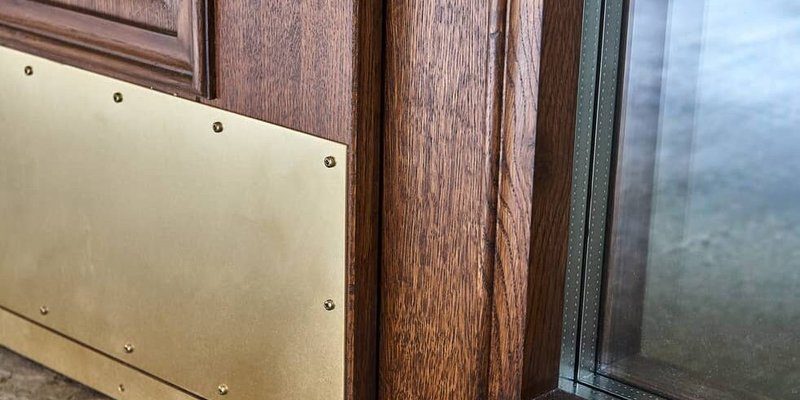
You might have a Schlage, Baldwin, or even a no-name brand kick plate. No matter the make or material, the issue is nearly universal. Kick plates, whether shiny brass or brushed steel, have a way of collecting everything from pet hair to gritty shoe debris. Let’s dive into what’s really going on, and what you can do about it.
What Exactly Is a Kick Plate—and Why Is It There?
Before we get into the why, let’s clear up what a kick plate actually is. It’s a thin strip, usually metal or plastic, mounted to the bottom of a door—often the front or back door. The main job? To take a beating, so your door doesn’t have to. Shoes, boots, pet claws, cleaning equipment—they all bump or scrape your door, and the kick plate absorbs the blow.
Honestly, if you’ve ever moved in groceries with your hands full, you’ve probably nudged the door open by kicking it. Over time, those tiny impacts would ruin paint or dent the wood. The kick plate is there because it’s cheaper and easier to replace than the whole door.
You might see different sizes and finishes. Some people even match them to their Schlage door hardware for a custom look. But regardless of style, they all sit right in the line of fire—exactly where dirt tends to settle and collect.
Why Do Kick Plates Seem to Attract So Much Dust?
Here’s the thing: kick plates are basically at ground zero for dust, dirt, and debris. Imagine a busy front door. Every time someone comes in, tiny particles from shoes, wind, or even a passing pet get stirred up. Where do those particles go? Right to the bottom of the door—where the kick plate lives.
Let me explain a bit further. Doors act like barriers. The air on either side of a closed door moves differently, and the tiny gap under the door lets air and dust flow right past the kick plate’s surface.
- Gravity: Dust doesn’t float forever. As it settles, it lands on the first thing it hits—often the kick plate.
- Airflow: Opening and closing the door creates a breeze, pulling dirt right onto the plate.
- Static electricity: Some metal finishes attract dust, especially right after cleaning or in dry, cool weather.
It’s not just your imagination. If you swipe a finger across, you’ll probably find a gritty line—more so than higher up on the door. The kick plate really does get the worst of it.
Material Matters: How Finish and Type Affect Dirt Buildup
Not all kick plates are created equal. The material and finish play a huge role in how much dust and dirt you see. For example, a polished brass plate from Baldwin might look high-end, but it’ll show every fingerprint and speck of dust. On the other hand, a brushed steel Schlage plate won’t be as shiny, but those tiny grooves can trap dirt and make it less noticeable.
There’s also the issue of static. Metal plates, especially aluminum or stainless steel, can build up a mild electric charge when rubbed or cleaned. That charge attracts dust—like when you pull laundry from the dryer and everything clings.
Plastic kick plates don’t have the same static issues, but they can get scuffed or scratched pretty easily. The more marks there are, the more places for dust to settle. Painted plates can chip, and those imperfections collect grime even faster.
Bottom line: The shinier and smoother your kick plate, the more likely you’ll notice every speck. But textured or darker finishes can just be hiding the mess—not keeping it away.
Location and Use: Why Some Doors Get Dirtier Than Others
You might be wondering why your back door’s kick plate looks filthy, but the front one is spotless—or vice versa. Location absolutely matters. High-traffic doors, like the mudroom or the door to your garage, pick up more dirt simply because more people and pets use them. Every time someone comes in from outside, they bring the outdoors with them.
Weather also plays a role. If your door faces a busy street, you’ll get traffic dust. If it’s in the path of the wind, more debris gets blown against it. And if you live in a dry climate, you’re actually more likely to see dust, since it’s lighter and floats farther.
Take a look at your entryway. Is there a porch or welcome mat? If not, dirt has a straight shot at your door. Even indoor doors (like to a laundry room) can collect lint and dust if there’s airflow or high use.
One more thing: if you have a smart lock, code keypad, or electronic remote on your door, you’ll probably stand there a few extra moments—giving dirt and dust more time to settle while you sync or enter your code.
Common Cleaning Mistakes That Make Things Worse
Here’s something people don’t always talk about: how you clean your kick plate can actually make it a bigger dust magnet. It sounds weird, but it’s true. For example, using a dry rag, or even worse, a paper towel, can build up static on metal plates. That electric charge pulls in even more dust.
Using harsh chemicals doesn’t help either. Some cleaners can leave a thin residue that’s slightly sticky—perfect for trapping new dirt. Abrasive scrubbers can scratch the surface, giving more nooks for grime to collect.
- Dry dusting: This moves dust around and increases static.
- Wet cleaning without drying: Water marks and streaks can collect more particles.
- Spray polishes: These might make the plate look shiny, but can act like glue for dust.
The best way? Use a damp microfiber cloth and gently wipe. If you want to go further, a tiny spritz of diluted mild soap can help. Always finish by drying with a lint-free towel.
How Airflow and Static Electricity Play a Role
Let’s dig a little deeper into airflow and static. These are the behind-the-scenes forces that make your kick plate so good at attracting dirt. When you open a door, especially quickly, you create a mini gust of wind. That breeze can swoop up loose particles, tossing them directly at the smooth, flat plate waiting at foot level.
Static electricity is sneakier. When you rub or clean the kick plate, you might not feel a zap, but a static charge builds up. Dust, which often has a neutral or opposite charge, is drawn right to it, sticking until you disturb it again. Cooler, drier weather makes static even stronger, so it’s not just bad luck if your kick plate looks worse in winter.
Think of it like shuffling across carpet in socks—the shock may surprise you, but before that, your hair stands up. Dust does the same, just in miniature, clinging to anything that holds a charge.
Is There Any Way to Prevent Dust on Kick Plates?
You might feel like kicking up your feet and giving up, but there are a few tricks to slow down the grime parade. First, tackle the source: put a bristly doormat outside and a softer one inside to trap shoe debris. Keep the area around the door swept or vacuumed so less dust has a chance to fly up.
When it comes to cleaning the plate itself:
- Use microfiber: This traps particles instead of spreading them.
- Anti-static polish: Look for products made for electronics or stainless steel—just don’t overdo it.
- Regular wipe-downs: A quick clean once a week is easier than scrubbing months of buildup.
If your kick plate is really beaten up, sometimes it’s easier to replace it than to try endless troubleshooting and cleaning. New plates aren’t too pricey, and you can pick a finish that hides dust better if that’s your top concern.
Do Some Kick Plates Stay Cleaner Than Others?
Sometimes, it feels like no matter what you do, some plates just look dirty again within hours. Honestly, it’s not all in your head. Certain plates do a better job of *appearing* clean, even if they’re still catching dust.
- Brushed or matte finishes don’t show every fingerprint or smudge—great for homes with lots of kids or pets.
- Darker colors can hide dirt better than shiny brass or chrome.
- Plastic plates won’t attract as much static, but may get scratched faster.
Some brands, like Schlage, offer kick plates with special coatings meant to resist fingerprints or static buildup. These can help, but nothing is totally maintenance-free.
Still, where you put the plate and how your space is used are often bigger factors than the brand or finish. Even the fanciest, high-tech plates are going to get dirty if the front door is your main entrance after a muddy hike, or if your dog likes to scratch at the door to be let in.
Final Thoughts: Living with a Dusty Kick Plate
A dusty, grimy kick plate isn’t a sign you’re messy—it’s just how doors and dirt work together. Whether yours is by Schlage, Baldwin, or any other brand, it’s sitting right in the path of every footstep, breeze, and static charge that comes its way. The key is to clean smart, use mats, and pick finishes that fit your lifestyle—especially if you’re tired of constant polishing.
So next time you look down and see another streak of dust, don’t stress. It’s just part of the deal when you want your door protected. With a little know-how and a quick wipe-down every so often, you can keep your kick plate looking as fresh as possible.
